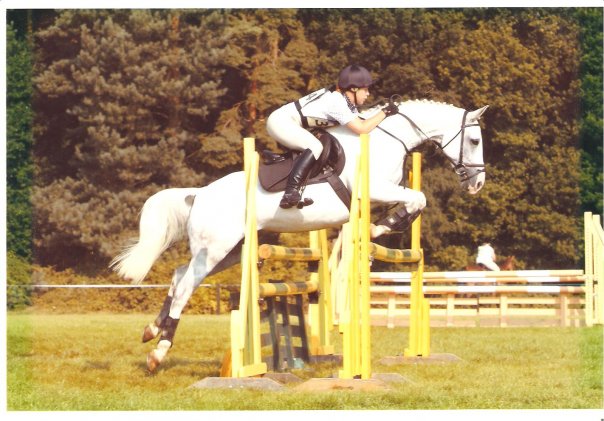
By Dr Jodie E. D.Smith, B VetMed
Most of us know how frustrating it is to train our horses for months for competition, only to be let down and be unable to compete due to injury. Injuries or illness can prolong the time taken to produce a successful competition horse and can lead to unwanted withdrawals or retirement from competition. Maintaining good health and fitness in any horse is Gold star practice! This is opposed to only calling the vet for attendance of lameness/ illness when it occurs- PREVENTION is key!! Hopefully maintenance will prevent large bills. Early recognition of problems such as lameness can prevent significant loss of training or competition time and can prolong the horse’s career.
Training
Training regimes for competitive horses need to be carefully planned as they can make or break a horse. Cardiovascular fitness is obviously vital in a competition horse but it is also very important that a gradual program is used to condition tendons, ligaments and bones e.g. slow jogging , cantering and hill work. This is especially true in young horses and those that will be put under high demands e.g. jumpers, high level dressage and western disciplines. Irregular or overtraining may lead to stress related conditions such as Gastric Ulceration. This may be interpreted as disobedience (e.g. resisting going in an outline), grumpy behaviour as well as mild colic and other symptoms. The ideal exercise regime is one in which regular work is maintained and any increase or decrease in intensity is done gradually whilst maintaining and building cardiovascular fitness.
Example working week: Jumping training with solid ground work 3x per week, flat work/ trail ride emphasising cardiovascular fitness 4x per week. Horse walkers or leading in hand can be utilised.
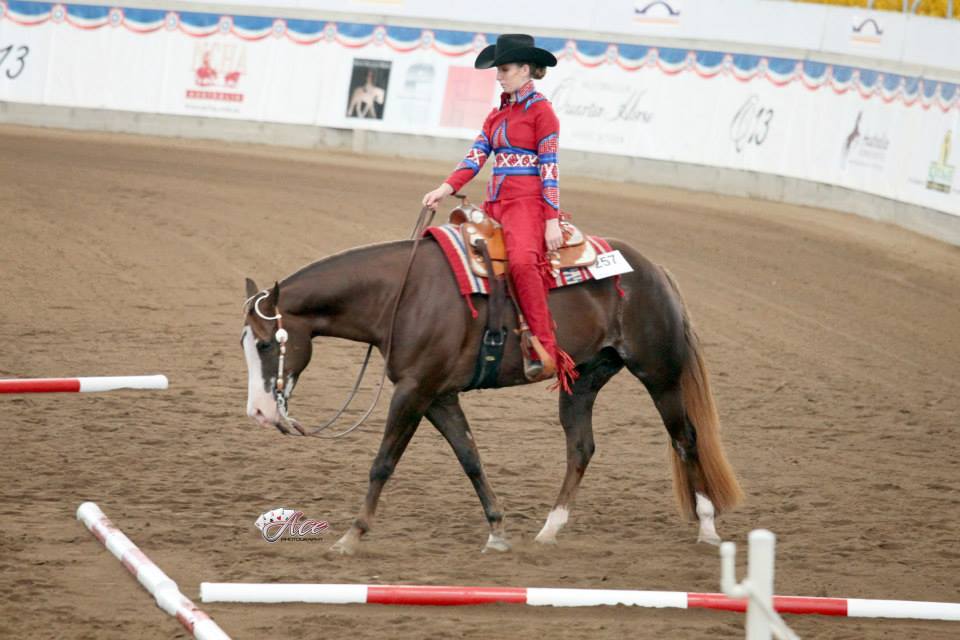 Nutrition
Nutrition
This topic is too vast to be fully covered in this article but it is important that any horse in work is receiving a balanced diet with enough calories for maintenance and replacement of glucose stores as well as allowing for muscular development. Most horses in hard/ heavy work will require some form of performance or competition mix as well as roughage in the forms of chaff and hay. However this should be tailored to the individual horse base on the amount of exercise as excessive food and excess weight is more expensive and can lead to other problems.
Heavier horses may be predisposed to a condition known as Polysaccharide Storage Myopathy and metabolic disorders related to energy stores. These horses may benefit from feeds that have a lower carbohydrate content and higher fat as the energy store to help prevent the conditions.
Preventative Medicine
Alongside preventing lameness with careful training, it is also in your horse’s best interest to prevent illness and promote wellbeing so as to have no interruptions in your training/ competition schedule and to keep you and your horse safe.
This includes keeping your horses’ vaccinations, worming, dentistry and farriery up to date. Many organisations are now making it compulsory for Hendra Vaccination e.g. Eventing NSW for any overnight events. Regardless of whether you are at a competition for an hour or overnight you and your horses are just as susceptible if you were to be exposed to a Hendra infected horse.
A side note for Hendra; we are no longer covered by our insurance company to visit any sick unvaccinated horses as it is deemed too risky. Many vets may refuse to visit your sick horse if it hasn’t been vaccinated, as they are the ones most at risk and you could be at risk also. The moral of this story- Please vaccinate all your horses against Hendra Virus.
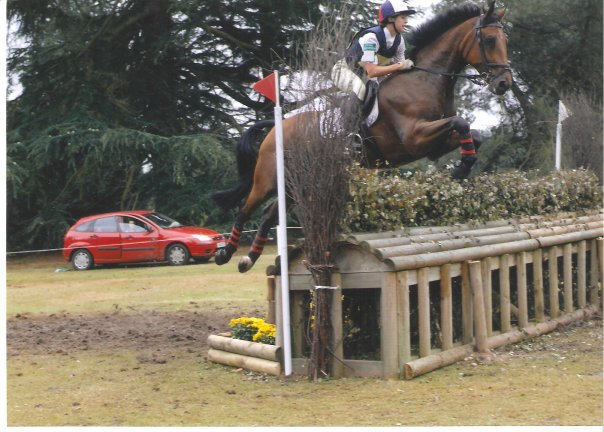 Competition Time
Competition Time
Whether you are entering a 2* event, local prelim dressage or going Cross-country schooling these same rules apply:
* Prior to travelling to the venue make sure your horse is free from lameness, illness or a fever (>38.5C).
* Allow time for an adequate warm up. At least 20-30 minutes depending on discipline. This may not apply in certain situations e.g. the previously mentioned metabolic storage myopathies which
may predispose to tying up if overly
warmed up.
* If during the discipline you feel as though your horse is struggling or less energetic than usual- pull out! It may be a warning sign.
* During times of drought many venues may have very hard ground. If this is the case, consider pulling out prior or going more slowly/ less competitively to prevent concussive and soft tissue injuries.
* On the flip side if the ground is very soft or slippery, studs may be required.
* Warm down fully. Keep horse moving until respiratory rate is normal, untack and lead in hand. (Perhaps nag a friend or partner to help if you have just jumped off after Cross-country).
* Cool off the horse- Hose/ bath to remove sweat. Ice legs- cooling gels, ice boots. Bandage legs to support soft tissues and promote circulation for recovery.
* Make sure before leaving your horse for the night that you have thoroughly checked for any wounds, lameness or swellings.
Recuperation
If your horse has exerted itself in competition or training it will have lost essential salts in its sweat. It is important afterwards to incorporate some Electrolyte replacements in your feeding regime. This isn’t necessary during normal medium intensity training.
As many of you have probably experienced cramping and stiffness after doing exercise you can understand how our equine partners may feel after a competition. It is necessary to make sure your horse is active in some way the day following competition e.g. a light trail ride or horse walker. It may also be useful to stretch out your horses’ limbs, neck and back.
If horses have been worked beyond their fitness ability, have severe electrolyte imbalances or have been fed a diet high in non-structured carbohydrates they may be susceptible to suffer from a condition known as Exertional Rhabdomyolysis, Tying up or Monday morning disease. This affects the muscle fibres and makes the horse very uncomfortable with stiff, firm, painful hindquarters, shifting hindlimb lameness and reluctance to move. This condition requires a veterinarian to medicate and possibly take bloods to diagnose fully. In horses that are known to suffer from this condition it is very important to turn them out and warm them down sufficiently post-exercise. Diet is a very important factor in controlling and working with horses with this problem.
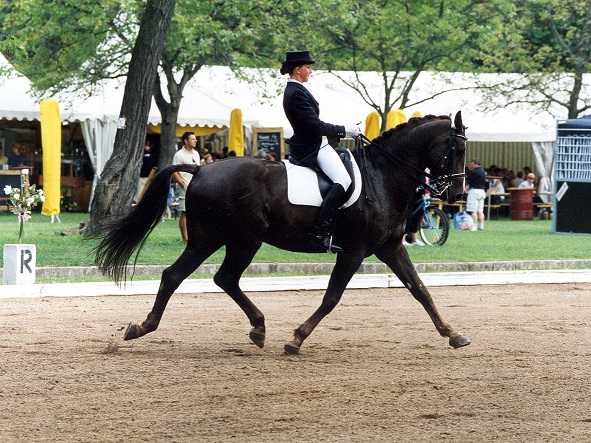 Soft tissue injuries such as tendon strain (tendonitis) may only become apparent a day or so after the incident. It is therefore important once home to check your horse over again for injuries/ wounds and call your vet if it needs attention.
Soft tissue injuries such as tendon strain (tendonitis) may only become apparent a day or so after the incident. It is therefore important once home to check your horse over again for injuries/ wounds and call your vet if it needs attention.
Now it is time for your horse to rest (walking exercise and paddock time) and train before heading off to the next competition.
Types of injuries
* Tendons & ligaments- Showjumpers and Dressage horses- Suspensory Ligament problems.
* Fractures- Racehorses & polocrosse/ polo horses/ campdrafters/ “rodeo event” horses
* Wounds
* Injuries to the foot
Tendon injuries: These can vary in severity. Blunt trauma, overstrain and tearing can cause a Superficial digital flexor Tendonitis- giving the back of the leg a bowed appearance
Tendon injuries from lack of fitness or overextension landing after a drop fence for example may cause broken fibres and core lesions in the tendon. Ultrasonography is required to visualise these injuries to assess the severity and give a prognosis.
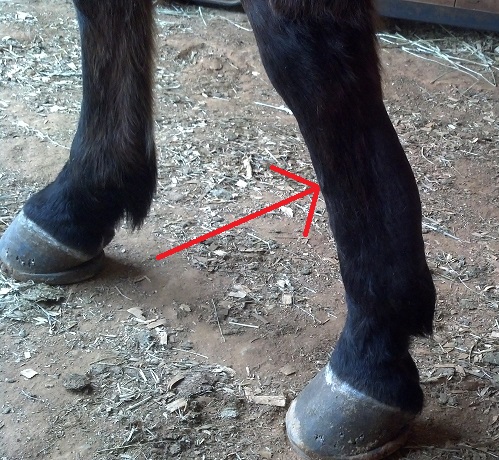 Clinical signs include lameness, swelling of the distal limb (mostly behind the canon), pulling up from cross-country, pain on palpation and/ or a dropped fetlock.
Clinical signs include lameness, swelling of the distal limb (mostly behind the canon), pulling up from cross-country, pain on palpation and/ or a dropped fetlock.
Treatment includes cold-hosing/ icing the limb, anti-inflammatories prescribed by your vet as well as box rest. Very severe injuries may need support with a splint or Robert Jones Bandage to travel and may need to be referred for surgery.
Wounds: What’s involved? Skin, tendons, synovial structures (joints), vasculature, body cavities?
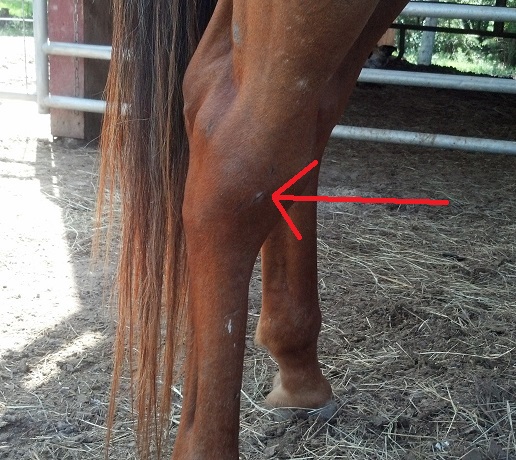 Wounds can be deceptive. Small, puncture wounds may penetrate a deep vital structure like a joint and need emergency attention where as large shocking wounds may heal amazingly well.
Wounds can be deceptive. Small, puncture wounds may penetrate a deep vital structure like a joint and need emergency attention where as large shocking wounds may heal amazingly well.
Wounds into a joint or synovial structure is life threatening and may cause relatively minor lameness before become severely lame in 24 hours. They require sterile flushing, intensive care and antibiotic treatment to prevent chronic arthritis and lameness. They may need referral to hospital facility for surgical flush and investigation. 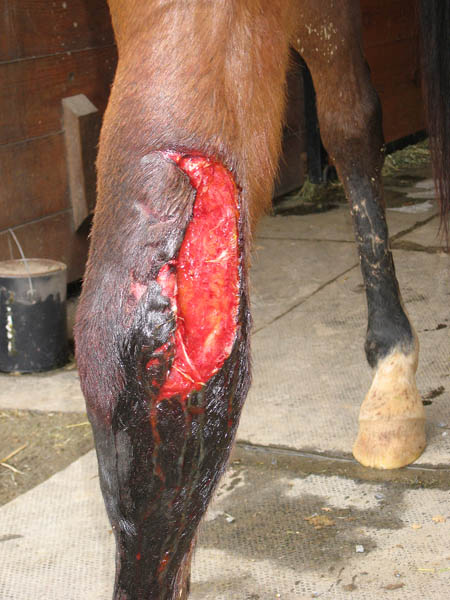
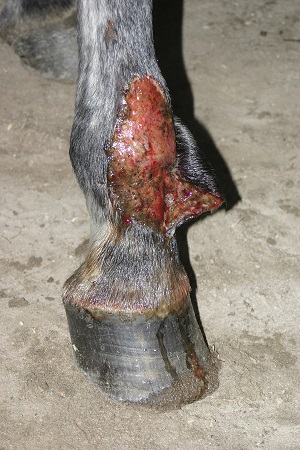
First aid- Stop bleeding with direct pressure. Clean the wound with a gently running hose or saline. If possible cover with a sterile dressing and bandage (with not too much tension) and call the vet as soon as possible. Please do not apply wound powders or sprays as these dry out wounds and interfere with healing or make proper examination of the wound difficult.
Large skin flap wounds may look bad but in fact are likely less serious and heal well.
Fractures: If you are suspicious that your horse has a fracture, don’t move them, keep calm, call the vet. Your horse will be non-weight bearing on the limb and it is usually very swollen and painful to touch. The limb will require stabilisation with a splint and X-rays to assess the location and severity. In adult horses fractured bones heal poorly and slowly and there are many complications which occur often during the treatment and recovery/ healing period. Many horses with fractures are euthanased.
Penetrating Foot Injuries: If possible don’t remove the nail or foreign body as it may be useful to X-ray the foot with it in situ to assess how deep it has gone and whether it has penetrated any vital structures. You can pack the bottom of the foot so that it doesn’t push in any further whilst waiting for the vet. The foot contains bones, joints, bursas and tendons that can all be affected by penetration.
N.B. Tetanus: It is important with any wounds or foot injuries that the horse’s tetanus cover is up to date. If it hasn’t been vaccinated within the last 6 months but is a vaccinated horse it may just require a booster vaccination. If it has never been vaccinated or its vaccination history is unknown it will require a Tetanus Anti-toxin injection as well.
First Aid Kit
It is useful for every horse owner to have a basic First aid kit for emergencies. Chance favours the prepared! Things to include:
* Poultice
* Vetwrap
* Elastoplast
* Sterile wound dressing
* Gloves
* Thermometer
* Scissors
* Bandage padding- Combine, Gamgee, cotton wool.
* Betadine/ Chlorhexidine solution.
This isn’t a complete list but it should get you out of trouble.
Conclusion
An injury to your horse at any time is frustrating but one at the wrong time may mean you are out for the whole competition season. Being aware of what signs to look for and what action to take may get you back on the circuit quicker and preferably prevent them happening in the first place. It also can’t be stressed enough how important routine maintenance of your horse is e.g. vaccinations and dentals etc. It also will give you a chance to discuss any concerns with your veterinarian before they get too bad e.g. gastric ulceration.









